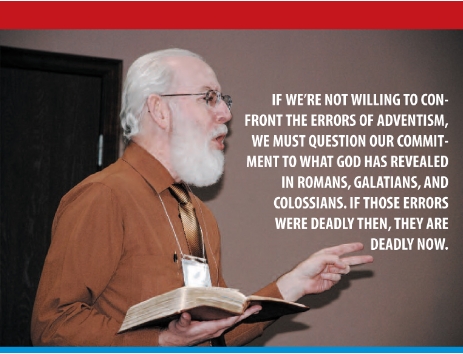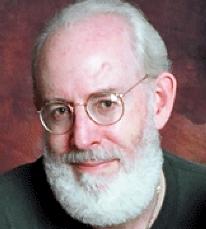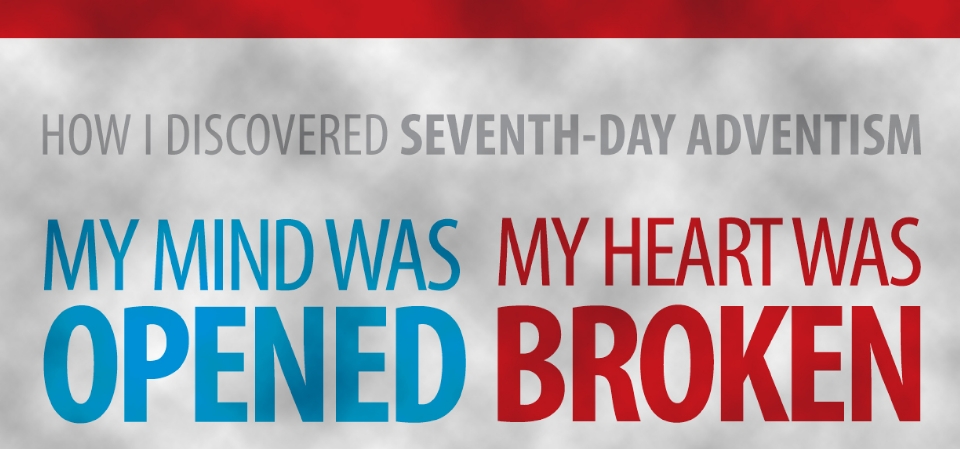
HOME / PROCLAMATION! MAGAZINE / 2014 / SPRING / HOW I DISCOVERED SEVENTH-DAY ADVENTISM

As Christians, we’re commanded to “test all things, hold fast to what is good, and abstain from every form of evil” (1 Thess. 5:21–22) . We’re also called to “defend the faith once for all delivered to the saints” (Jude 3–4). Sometimes, however, despite our sincerest efforts and best intentions, we may be subject to a type of blindness. I thank the Lord that, while it may be persistent and even profound, that blindness is not necessarily incurable.
I’d like to share my journey out of blindness with you.
Apologetics changed me
I first became aware of countercult apologetics when I was in high school. On a rainy day I ran across The Kingdom of the Cults on a friend’s bookshelf, and what it revealed about Mormonism, Jehovah’s Witnesses, Christian Science, and other groups changed my life.
Yet I cannot deny that I was anesthetized by its author, Walter Martin—the legendary founder of the Christian Research Institute, the original “Bible Answer Man,” godfather of the evangelical countercult movement—for the book contained a 63-page appendix called “The Puzzle of Seventh-day Adventism” in which he sought to explain why Adventism, though problematic, was somehow outside the borders of the theological “kingdom of the cults”. Over the years I tried to read that appendix several times. I’m ashamed to admit it, but without fail, each time my eyes glazed over.
Meanwhile, I attended Walter Martin’s packed Sunday-morning class at Melodyland Christian Center for about three years before I joined his staff, gobbling up everything he had to say about cults, discernment, and defending the Gospel. At times he’d go out of his way to call Seventh-day Adventists fellow Christians and his personal friends, to talk about speaking in their Sabbath-school classes, and so on. His comments were like a badge of tolerance.
On a more personal level, he credited Adventist physicians with prolonging, if not saving, his life. He even sent me to an Adventist doctor to get all my immunizations before my first trip to Africa in 1981.
Thirty years ago, Adventism was seldom in the news—except for the Davenport Scandal and Walter Rea and The White Lie. But even then, the movement looked odd, but not ominous; enigmatic, but not evil. And always I knew this: that in the face of opposition, Walter Martin—the original Bible Answer Man!—had pronounced Seventh-day Adventism not a cult. He had virtually staked his reputation on it. And whatever else Adventism may have been, that declaration was enough for me. I had other theological fish to fry.
Besides, as a cult researcher, I knew of ex-Mormon groups, ex-Jehovah’s Witness groups, former Christian Scientists, and ex-Armstrongites, but I wasn’t aware of even one actual group of former Adventists. For that matter, I didn’t really know any Adventists. Surely that had to mean something.
Adventist comfort food
In the mid-1980s I moved to South America to start a Brazilian counterpart to the Christian Research Institute. To my annoyance, it soon became evident that the staff were fervently opposed to Adventism. I learned that Brazilian Adventists were actively engaged in proselytizing evangelicals, and they boasted openly of trophy pastors they’d converted. I wrote this off as a mutant form of the religion. And, if you can believe it, even though I finally gave in to my Brazilian research staff and let a former Adventist pastor (a Chilean man named Raul) lecture at some of our seminars, I still never quite got the point.
I saw the feature film Cry in the Dark about Michael and Lindy Chamberlain, the Australian Adventist couple suspected of murdering their child and accused of being devil-worshipers of some kind, but I knew that was sensationalistic bunk.
Meanwhile, my first two children were born in the Adventist Hospital of São Paulo in Brazil. Moreover, we eagerly bought and ate Seventh-day Adventist peanut butter and honey and not infrequently dined at the Superbom Adventist vegetarian restaurant. Again, as an apologist and cult researcher, it always seemed to me that where there’s smoke, there’s fire; but for the most part I never detected much more from Adventism than a kind of damp, moldy smell. Besides, time had shown that Adventism was a topic on which reasonable people could disagree.
When I returned to the Christian Research Institute in California in the late 1980s, I learned that my colleague Ken Samples had met personally with Adventist scholars and produced two influential articles declaring that Adventism came in three fairly distinct flavors…but it still did not meet the operating definition of a cult. Again I was anesthetized into unconcern.
Crossing the threshold
I left the Christian Research Institute in 1995. Three years later the video Seventh-day Adventism: The Spirit Behind the Church was released. I thought it was well made, and parts of it were fascinating and even disturbing. But as I can recall I was still strangely unmoved on a deeper level; certainly nothing stirred me to action.
That same year I went to Chicago to attend the national conference of Evangelical Ministries to New Religions (EMNR). One of the speakers was Dale Ratzlaff. His calm and systematic presentation on Adventism—and the fact that he was himself a former Adventist pastor—forced me to sit up and take notice in a new and different way. I realized that I’d never really begun to understand Adventism.
Some years later I was asked by a foundation to arrange for leaders of other evangelical discernment ministries to make presentations to their staff. I remembered Dale, and I arranged for him and Carolyn and another couple named Richard and Colleen Tinker to speak one morning. Afterwards we all went out to lunch. And that time of interaction set the stage for me to fully cross the threshold.
 In 2007 I visited Richard and Colleen Tinker in their home, accompanied by our ministry’s Russian director, Pasha Stolyarov. Richard and Colleen patiently answered my questions, hour upon hour, as I sought to fit Adventism historically, culturally, and theologically into the categories that would help me determine with certainty whether I was dealing with a merely marginal movement or something profoundly deceptive and even destructive. By day’s end the verdict was disturbing, but clear: Seventh-day Adventism distorts or denies nearly every central teaching of the historic Christian faith. While its façade is benign, the devil is in the details.
In 2007 I visited Richard and Colleen Tinker in their home, accompanied by our ministry’s Russian director, Pasha Stolyarov. Richard and Colleen patiently answered my questions, hour upon hour, as I sought to fit Adventism historically, culturally, and theologically into the categories that would help me determine with certainty whether I was dealing with a merely marginal movement or something profoundly deceptive and even destructive. By day’s end the verdict was disturbing, but clear: Seventh-day Adventism distorts or denies nearly every central teaching of the historic Christian faith. While its façade is benign, the devil is in the details.
The Seventh-day Adventist church claims to be God’s special, end-time remnant church, guided by God’s special, end-time prophet, Ellen G. White.
Along with its weird, unscriptural views on the Trinity and the person and work of Jesus Christ, the “Great Controversy” theme and the Investigative Judgment, and the incredible amount of material that Ellen White simply made up, Adventism…
- confuses law and gospel
- denies the biblical doctrine of hell
- claims that Satan is a sin-bearer for Christians
- denies that human beings possess an immaterial soul or spirit
- employs the deceptive Clear Word version of the Bible
If we’re not willing to confront the errors of Adventism, we must question our commitment to what God has revealed in Romans, Galatians, and Colossians. If those errors were deadly then, they are deadly now. They’re not merely abstractions about which we can politely disagree. If the Bible is to be believed, souls are at stake, and we cannot—we must not—remain silent.
I’m convinced that evangelicals around the world desperately need a straightforward summary of Adventism’s toxic doctrines and their impact on the people who follow them.
Individual Seventh-day Adventists need the biblical gospel. Institutional Adventism—which binds them in spiritual chains—must be responsibly exposed and consistently, conscientiously opposed. If we love the truth, we will oppose the errors of Adventism by every available and appropriate means. And if we love the truth, we will love the Adventist people enough to speak the truth to them—with humility, conviction, and compassion.
Non-biblical doctrines
What separates Seventh-day Adventism from biblical Christianity today? There are many areas of serious conflict, but three stand out:
• Ellen G. White. Considered “the Lord’s messenger” and the “spirit of prophecy,” Mrs. White is central to Seventh-day Adventism. The nature of her role as a “continuing and authoritative source of truth” for the church (as stated in their Fundamental Belief #18) demands that we judge her affirmations by biblical tests of a prophet (such as Deut. 18:21–2). Mrs. White wrote copiously, claiming that God had given her visions of the past, the future, and even the sinless and smiling inhabitants of other planets. Though she was not always in error, in her revelations she contradicts not only the Bible, but herself. At times she undermines the deity of Christ, indicates that He had a sinful nature while on earth, and declares His atoning work on the cross incomplete. Mrs. White also places an unbearable—and fundamentally unscriptural—burden of righteousness through works on her followers, and labels the teaching that Christ’s imputed righteousness fulfills the law as “gross deception” (Signs of the Times, Feb. 25, 1897, par. 7). We now know that she plagiarized vast amounts of material in her supposedly inspired writings—a fact that church leaders have actively sought to suppress.
• Investigative Judgment. Right after the “Great Disappointment” of Miller’s failed 1844 prediction, an Adventist named Hiram Edson said he received a vision clarifying the prediction’s true meaning. Instead of Christ’s Second Coming, the completed 2,300-day period of Daniel 8:14 signaled Jesus’ transition from one compartment of the heavenly sanctuary to the next. Adventists explain that He did this to initiate a long-term “investigative judgment” of professed Christians. This convoluted new doctrine—which has no scriptural support—was intended to solve one problem, but instead unleashed a host of others. Serious Adventists live in fear that they will be lost for eternity because Christ will plead their case only if they are found worthy.
• Remnant Church. Adventism promotes the elitist view that it is the true church portrayed in Revelation chapter 12. Naturally, this means that other churches are apostate and lack the “full truth”—giving Adventists license to seek converts among evangelicals, often through stealth techniques like “Revelation seminars.”
Love is not silence
Love is not apathy. Love is not silence. When I did not know, I could not love as I ought; but now that I do know, I have no choice. None of us who recognizes the depth of the deception in Adventism does.
Perhaps your mind and heart are in a place much like mine were for so many years. If you’re at a crossroads, perhaps this article is a long-overdue signpost to guide you to continue your journey.
Brothers and sisters, we need to heed the Scriptures and test all things; we must defend the faith once for all delivered to the saints.
The Lord’s bond-servant must not be quarrelsome, but be kind to all, able to teach, patient when wronged, with gentleness correcting those who are in opposition, if perhaps God may grant them repentance leading to the knowledge of the truth, and they may come to their senses and escape from the snare of the devil, having been held captive by him to do his will (2 Tim. 2:24–26).
Making those teachings and their consequences known—and offering the scriptural antidote—is at the heart of the vital work being done by Life Assurance Ministries (LAM). God used LAM to help me overcome my deficit of discernment—my lack of comprehension and compassion.
It’s taken me time to reconcile the different approaches needed to deal with institutional Adventism and individual Adventists, so my decision to join the resistance movement has been neither sudden nor pleasant. But I’ve had no alternative.
I can appreciate the skepticism of anyone who doubts that the alleged problems in Adventism really amount to much. After all, this is a movement with a vast system of schools, an impressive worldwide publishing effort, and an unrivaled network of medical facilities. Could it be that someone as undeniably admirable as Dr. Ben Carson is a weirdo, or some kind of cultist?
Here, however, is the inconvenient truth: a high regard for Adventism as a system or of the Seventh-day Adventist church as an institution usually corresponds to a low regard for the suffering of the millions of people who are so often and easily damaged by it.
I have reached the conclusion that Seventh-day Adventism—as a system—is deeply heretical and undeniably cultic. It is not a normal church. Nevertheless, Scripture tells us how to proceed.
The Apostle Paul writes to Timothy in his first letter that, in contrast to those who “teach strange doctrines,” “the goal of our instruction is love from a pure heart and a good conscience and a sincere faith” (1 Tim. 1:5).
Paul further writes to the Galatians, “I am astonished that you are so quickly deserting the One who called you by the grace of Christ and are turning to a different gospel—which is really no gospel at all. Evidently some people are throwing you into confusion and are trying to pervert the gospel of Christ” (Gal. 1:6-9).
He also writes: “Let us not lose heart in doing good, for in due time we will reap if we do not grow weary” (Gal. 6:9).
Finally, he exhorts Timothy that “The Lord’s bond-servant must not be quarrelsome, but be kind to all, able to teach, patient when wronged, with gentleness correcting those who are in opposition, if perhaps God may grant them repentance leading to the knowledge of the truth, and they may come to their senses and escape from the snare of the devil, having been held captive by him to do his will” (2 Tim. 2:24-26).
May God grant all of us the courage—indeed, the clarity of sight—to act obediently in response to what He has so plainly revealed. †
___________
Adapted from a message delivered at the 2013 Former Adventist Fellowship conference in Redlands, California.

Copyright 2014 Life Assurance Ministries, Inc., Camp Verde, Arizona, USA. All rights reserved. Revised May 6, 2014. Contact email: proclamation@gmail.com
 Paul Carden is executive director of The Centers for Apologetics Research. He has devoted over 30 years of his life to cult-related research and outreach in Latin America, Africa, eastern Europe, and the former Soviet Union. He spent 15 years working with Walter Martin in the Christian Research Institute, spending six years in Brazil and six as co-host of the live radiobroadcast “Bible Answer Man”. He is also the general editor for various apologetics-oriented pamphlets produced by Rose Publishing, and his articles have appeared in a variety of missions and ministry publications. He and his wife Lisa have four children.
Paul Carden is executive director of The Centers for Apologetics Research. He has devoted over 30 years of his life to cult-related research and outreach in Latin America, Africa, eastern Europe, and the former Soviet Union. He spent 15 years working with Walter Martin in the Christian Research Institute, spending six years in Brazil and six as co-host of the live radiobroadcast “Bible Answer Man”. He is also the general editor for various apologetics-oriented pamphlets produced by Rose Publishing, and his articles have appeared in a variety of missions and ministry publications. He and his wife Lisa have four children.

S P R I N G • 2 0 1 4
VOLUME 15, ISSUE 1